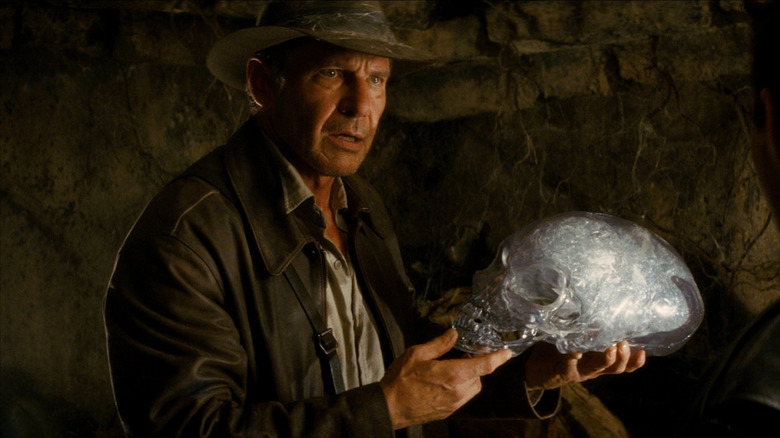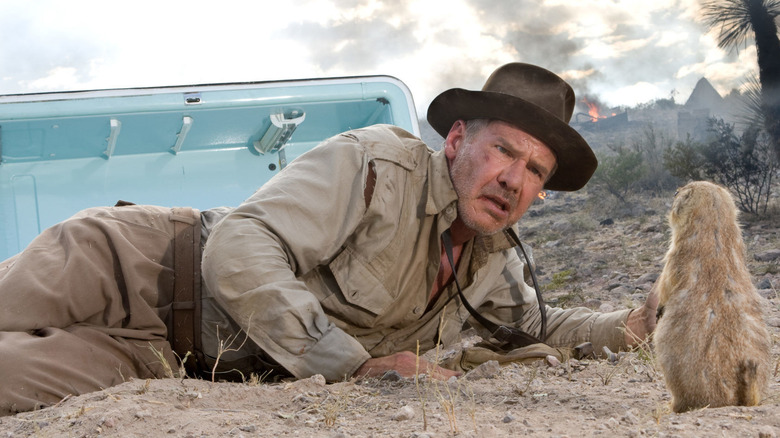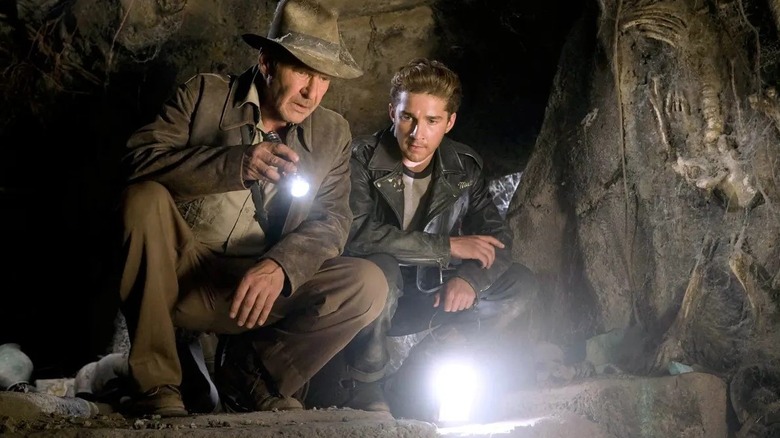Indiana Jones' Cinematographer Was Concerned By Crystal Skull's Script
Steven Spielberg's 2008 film "Indiana Jones and the Kingdom of the Crystal Skull" is unlike the previous three Indiana Jones movies in several vital respects. One might have noticed that the previous movies all featured holy artifacts from one of Earth's major practiced faiths. The Ark of the Covenant from "Raiders of the Lost Ark" is a relic sacred to the Jewish people. The Sankara Stones from "Indiana Jones and the Temple of Doom" aren't real, but they are based on Shiva lingams, smooth stones found throughout India in Hindu temples devoted to Shiva. "Indiana Jones and the Last Crusade" saw the title archaeologist finding the Holy Grail, the cup that Christ used during the Last Supper in Christian mythology. In contrast, "Kingdom of the Crystal Skull" saw Indy searching for ... an alien skull.
While crystal skulls are believed to be a part of ancient Aztec and Mayan religious practices, Indy is not excavating any civilizations to find one. The skull is, instead, a literal skull, taken from an alien corpse hidden deep in the jungles of South America. Indy and a group of ambitious, power-hungry Russians (represented by Cate Blanchett) are all eager to find the headless alien corpse solve the crystal skull's mysteries. They could have saved money and merely purchased some vodka from Dan Aykroyd.
"Crystal Skull" is not terribly beloved by Indiana Jones fans, and has faced harsh criticism over the years. During production, even the crew faced some trepidation. Notably, celebrated cinematographer Janusz Kamiński, who has shot 20 of Spielberg's films, was concerned that David Koepp's screenplay was too busy. He admitted as much in a May 2023 interview with the website American Cinematographer.
Nuking the fridge
Kamiński noted that, despite the various accusations directed at the quality of "Crystal Skull," it was actually the largest production of the series to date. It was to have more set pieces, more fights, more high-concept chases and escapes. It certainly had more lead characters than the previous movies, which tended to be pretty lean. Kamiński was especially put off by Keopp's tendency to write vital exposition into the middle of action sequences. As any filmgoer might tell you, exposition can easily be missed if it's being given at the same time as an action scene that serves to upstage it. This is an issue for a cinematographer who would have to shoot scenes framed up for wide-angle action as well as up-close dialogue coverage.
Kamiński said:
"['Crystal Skull'] was a very big undertaking, much more so than the other movies Steven and I have done together. When I read the script, I was concerned with the amount of action; a lot of dialogue is delivered while the characters are fighting, kicking, riding motorcycles and jumping from car to car, so I knew we'd be covering scenes for dialogue while actors were constantly on the move. There were very complex shots, and we were also shooting anamorphic, which complicated everything even more."
Whether or not Kamiński was successful will have to be a matter of some discussion. He certainly was able to shoot action and dialogue at the same time, although a single viewing of "Crystal Skull" does reveal that some explanatory dialogue is left in the visual dust.
Shooting techniques
Kamiński didn't shoot the previous Indiana Jones movies, having taken over the job from Douglas Slocombe, so he felt the pressure to recreate his look that had been firmly established in a series of ultra-popular movies. Kamiński not only had to recreate the look but also update it for 2008 audiences, all while using newer, more exciting equipment. Visual clarity, it seems, was key. Kamiński said:
"There's a legacy and a strong following with these movies that you have to respect, and Steven and I began our prep by watching the first three movies together. [...] An Indiana Jones film has to have that glossy, warm look with strong, high-key lighting. It's suspenseful but not too dark — you always see things clearly. We also had to recognize that we couldn't use some of the same tricks that worked 20 years ago because the audience has become more sophisticated; today, you can't use a torch in a cave scene and have light coming from other directions."
It seems that modern audiences have become savvy to the artificiality of film, and would be able to spot when an artificial light source is included in a natural setting. Updating the technology to make light look more like it came from a natural source seemed to be high on Kamiński's radar. He continued, "We were always asking, 'How can we do this as well as Douglas Slocombe but make it a bit more contemporary?'"
In that regard, Kamiński was most certainly successful. Whatever the quality of "Crystal Skull" overall, Kamiński's photography is great.


